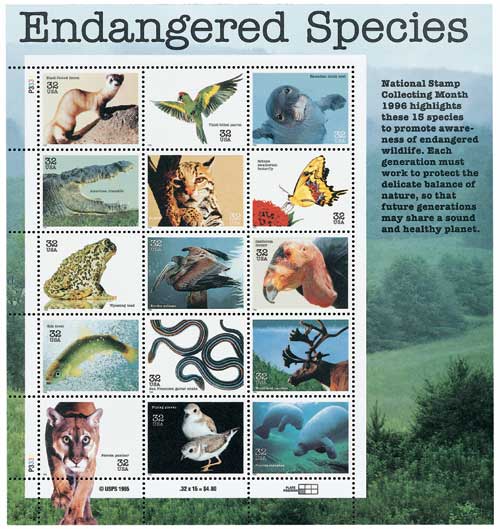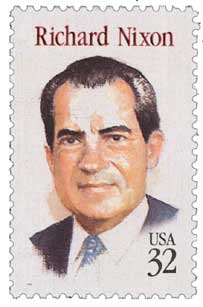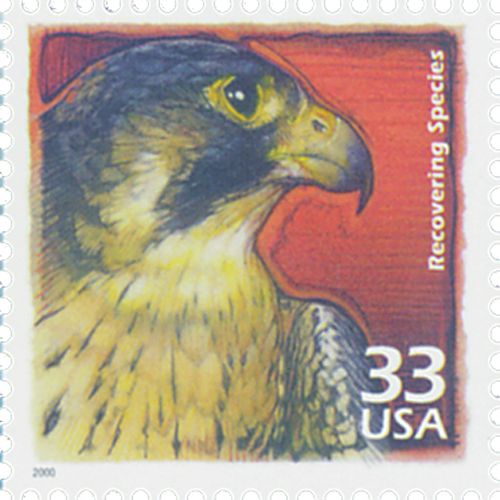
# UX264-78 FDC - 1996 20c/32c Combo PC/15 Endangered Species
Endangered Species Act

On December 28, 1973, President Richard Nixon signed the Endangered Species Act into law in an effort to protect threatened species from extinction.
Throughout the late 1800s and early 1900s, people around the globe grew increasingly concerned about the plight of animals nearing extinction. As the bison neared extinction and the passenger pigeon disappeared, people began calling for wildlife conservation. Proponents of the conservation movement introduced the larger American public to the idea of extinction.
These animals were dropping in numbers due to many factors. Many were hunted for food, study, and personal or museum collections, while a large number of birds were killed for their feathers to adorn hats. Additionally, towns, cities, and farms expanded, encroaching on habitats, while pesticides and non-native species added to the burden.

The first major step taken in the US was the Lacey Act of 1900, which was the first federal law to regulate commercial animal markets. It made it illegal to sell animals between states that violated state game laws. In the coming years, more laws were passed to protect animals, including the Migratory Bird Conservation Act of 1929 and the Bald Eagle Protection Act of 1940.

Another major victory came with the Endangered Species Preservation Act of 1966. This act established a list of native US animal species that were endangered and provided limited protections for them. This act also allowed the Fish and Wildlife Service and federal land agencies to set aside habitats for the affected species. The first list appeared in 1967 and included 14 mammals, 36 birds, 6 reptiles and amphibians, and 22 fish.

The Endangered Species Conservation Act later amended this law in 1969. This act allowed for additional protection of animals at risk of “worldwide extinction,” prohibited them from being imported or sold in the US, and expanded the Lacey Act’s ban on interstate sales to include more species. The 1969 amendment also requested an international meeting for all nations to join in and adopt a worldwide treaty to protect endangered species. The conference was held in February 1973 and resulted in the Convention on International Trade of Endangered Species of Wild Fauna and Flora (CITES).

Also in 1973, President Richard Nixon announced that he believed the current conservation laws weren’t strong enough and encouraged Congress to pass more wide-reaching and effective legislation. Congress enlisted the help of lawyers and scientists to pen a brand new Endangered Species Act (ESA). Nixon approved it and signed it into law on December 28, 1973. The ESA helped to completely shift the way environmental protection was handled in the US. Notably, the act’s goal was to protect the species as well as their ecosystems.

Today the ESA protects over 2,300 species. In the years since its passage, over 70 species have been de-listed because their numbers have recovered due to conservation efforts.
Click here for more Endangered Species stamps.
Click here to read the Endangered Species Act.
Endangered Species Act

On December 28, 1973, President Richard Nixon signed the Endangered Species Act into law in an effort to protect threatened species from extinction.
Throughout the late 1800s and early 1900s, people around the globe grew increasingly concerned about the plight of animals nearing extinction. As the bison neared extinction and the passenger pigeon disappeared, people began calling for wildlife conservation. Proponents of the conservation movement introduced the larger American public to the idea of extinction.
These animals were dropping in numbers due to many factors. Many were hunted for food, study, and personal or museum collections, while a large number of birds were killed for their feathers to adorn hats. Additionally, towns, cities, and farms expanded, encroaching on habitats, while pesticides and non-native species added to the burden.

The first major step taken in the US was the Lacey Act of 1900, which was the first federal law to regulate commercial animal markets. It made it illegal to sell animals between states that violated state game laws. In the coming years, more laws were passed to protect animals, including the Migratory Bird Conservation Act of 1929 and the Bald Eagle Protection Act of 1940.

Another major victory came with the Endangered Species Preservation Act of 1966. This act established a list of native US animal species that were endangered and provided limited protections for them. This act also allowed the Fish and Wildlife Service and federal land agencies to set aside habitats for the affected species. The first list appeared in 1967 and included 14 mammals, 36 birds, 6 reptiles and amphibians, and 22 fish.

The Endangered Species Conservation Act later amended this law in 1969. This act allowed for additional protection of animals at risk of “worldwide extinction,” prohibited them from being imported or sold in the US, and expanded the Lacey Act’s ban on interstate sales to include more species. The 1969 amendment also requested an international meeting for all nations to join in and adopt a worldwide treaty to protect endangered species. The conference was held in February 1973 and resulted in the Convention on International Trade of Endangered Species of Wild Fauna and Flora (CITES).

Also in 1973, President Richard Nixon announced that he believed the current conservation laws weren’t strong enough and encouraged Congress to pass more wide-reaching and effective legislation. Congress enlisted the help of lawyers and scientists to pen a brand new Endangered Species Act (ESA). Nixon approved it and signed it into law on December 28, 1973. The ESA helped to completely shift the way environmental protection was handled in the US. Notably, the act’s goal was to protect the species as well as their ecosystems.

Today the ESA protects over 2,300 species. In the years since its passage, over 70 species have been de-listed because their numbers have recovered due to conservation efforts.
Click here for more Endangered Species stamps.
Click here to read the Endangered Species Act.












